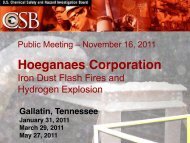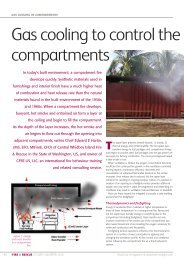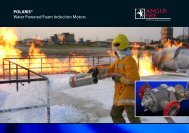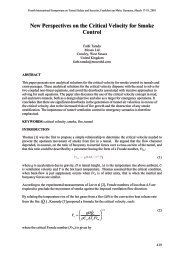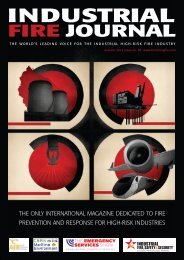Evacuation in Complex Environments - Industrial Fire Journal
Evacuation in Complex Environments - Industrial Fire Journal
Evacuation in Complex Environments - Industrial Fire Journal
You also want an ePaper? Increase the reach of your titles
YUMPU automatically turns print PDFs into web optimized ePapers that Google loves.
Fourth International Symposium on Tunnel Safety and Security, Frankfurt am Ma<strong>in</strong>, Germany, March 17-19, 2010<br />
evacuate through narrow passages or down ladders, which means that there is an apparent risk of<br />
<strong>in</strong>jury. The environmental conditions may also impose other difficulties such as problems hear<strong>in</strong>g an<br />
evacuation alarm because of background noise and problem mov<strong>in</strong>g to a place of safety due to narrow<br />
passages and obstacles <strong>in</strong> the path of travel. These types of factors make the environment complex<br />
with regards to fire evacuation which can form extra hazards that have to be dealt with dur<strong>in</strong>g<br />
operation <strong>in</strong> the complex spaces.<br />
Much of the preventive work safety relies on traditional procedures and not much work has been<br />
published focus<strong>in</strong>g on the special problems fac<strong>in</strong>g workers dur<strong>in</strong>g evacuation from these complex<br />
environments. Special attention has therefore been made to <strong>in</strong>vestigate the special conditions that may<br />
be present for these environments.<br />
The nature of the problems <strong>in</strong> the complex environments are similar to those <strong>in</strong> traditional assembly<br />
type build<strong>in</strong>gs, i.e. there are problems gett<strong>in</strong>g aware of the fire threat, the cues related to fires have to<br />
be <strong>in</strong>terpreted and a decision mak<strong>in</strong>g process has to be <strong>in</strong>itiated and f<strong>in</strong>ally there is a movement<br />
distance between the location of the people and a safe place. Obviously, there are differences which<br />
are related to the <strong>in</strong>creased complexity of the environment. Some aspects that may <strong>in</strong>crease the<br />
complexity are:<br />
- Visual access – limited visual overview, dim light<strong>in</strong>g, darkness, etc<br />
- Sound level – noisy environments, background noise, etc<br />
- Familiarity – unfamiliar environment, constantly chang<strong>in</strong>g environment, etc<br />
- Obstacles and narrow passages – manholes, drops, etc<br />
- Difficult passages or bottle-necks – ladders, remote locations (e.g. cranes), airlocks, etc<br />
- Work that needs to be term<strong>in</strong>ated properly due to safety reasons – weld<strong>in</strong>g, crane operation,<br />
etc<br />
- Isolated environment – long distance to a safe location, low visual access to the surround<strong>in</strong>gs<br />
etc.<br />
In order to demonstrate some of the factors <strong>in</strong>fluenc<strong>in</strong>g the evacuation conditions present <strong>in</strong> the<br />
complex environments an evacuation experiment was performed <strong>in</strong> a tunnel bor<strong>in</strong>g mach<strong>in</strong>e (TBM)<br />
used for construct<strong>in</strong>g a railway tunnel <strong>in</strong> Sweden. The TBM, which is over 240 m long and has a<br />
diameter of over 10 metres, has currently proceeded approximately 5 kilometres <strong>in</strong>to the mounta<strong>in</strong>.<br />
The typical problems for this scenario are that there is only one escape route, the noise level is high<br />
and it is difficult to have visual access of the environment.<br />
The safety for the tunnel workers has also been <strong>in</strong>vestigated us<strong>in</strong>g a simple one-dimensional<br />
evacuation model. The model determ<strong>in</strong>es the possibility for cont<strong>in</strong>uous evacuation for persons <strong>in</strong> a<br />
tunnel given a prescribed fire development. It is necessary for the tunnel construction operator to<br />
<strong>in</strong>vestigate different fire scenarios that can occur as perform<strong>in</strong>g experiments and drills can only<br />
capture some aspects of the possible outcome of an accident. Therefore modell<strong>in</strong>g and physical<br />
experiments have to complement each other to broader the picture and provide <strong>in</strong>put for additional<br />
safety assessment. The paper, therefore, <strong>in</strong>troduces a simple MATLAB model that can be used for an<br />
<strong>in</strong>itial sensitivity analysis of the evacuation situation for the tunnel workers.<br />
The evacuation research is part of the ongo<strong>in</strong>g research project “<strong>Fire</strong> safety <strong>in</strong> tunnels dur<strong>in</strong>g<br />
construction” which is supported by The Swedish Civil Cont<strong>in</strong>gencies Agency (MSB) and led by the<br />
Technical Research Institute of Sweden <strong>in</strong> Borås. The purpose for the ma<strong>in</strong> research project is to<br />
<strong>in</strong>vestigate the fire behaviour, the occupant evacuation conditions and the needs for a proper rescue<br />
operation <strong>in</strong> tunnels, which are under construction. The research project is runn<strong>in</strong>g to the end of 2010.<br />
This paper is based on a paper [5] presented at the 4 th International Symposium on Human Behaviour<br />
<strong>in</strong> <strong>Fire</strong>, 13-15 July 2009.<br />
182



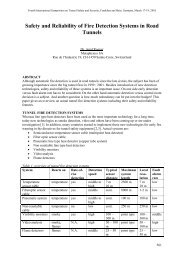

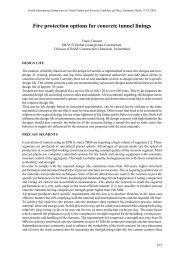
![30-37 TunnelsREV[1]rev.qxd - Industrial Fire Journal](https://img.yumpu.com/22237435/1/184x260/30-37-tunnelsrev1revqxd-industrial-fire-journal.jpg?quality=85)
